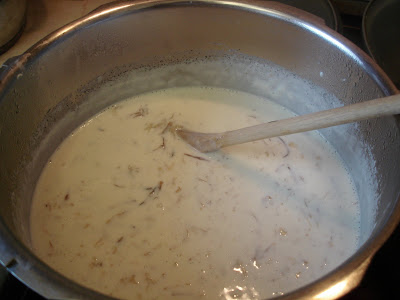Carageen what! - Unless you've been to Ireland you are unlikely to have come across
carageen seaweed much. But you might be surprised at how much it crops up on ingredient lists of commonly eaten foods. Last Summer I met fellow blogger
Peggy when I visited Cork, Ireland on a short trip. One of the stops on our day-trip was to the English market in Cork. I had wanted to try Carageen for a number of years after seeing it featured on a Rick Stein TV programme.
 Carageen seaweed
Carageen seaweed is common on beaches in Ireland and is also known as
Irish Moss. It is traditional to use carageen as a thickener for soups, sauces, and to thicken milk in order to make Carageen Pudding.

Dried carageen is washed and soaked in water to soften it.

Dropped in milk and brought to the boil for about 20 minutes. You can flavour it with any number of things. I added a
vanilla pod to mine. Gradually you will see the milk thicken like custard as the carageen releases its gelatine. Another way that carageen is used commercially is in the thickening of low fat yoghurts and low calorie diet foods. Have a look on the list of ingredients next time you are in a supermarket.

The milk thickens up as the carageen gets softer and softer. It has no real taste of its own so this was really a test for me. Next time I might use cardamom, or honey, or lemon.

When thickened strain through a sieve and push the remains of the gelatine through the sieve. I then whisked into the mix a couple of spoons of sugar, one egg yolk, then folded in an egg white. This adds quite a bit of air to the pudding and gives it a lovely light texture.

In only a couple of hours it had set into a lovely light carageen pudding. This would be lovely I think with some stewed fruit or a raspberry sauce. It would also set beautifully into a shaped mould.
 Seville oranges have so many pips it is unbelievable! Don't throw them away if you are making marmalade because they are a very rich source of pectin that helps set the jam. Jam making is reliant on a good set which is obtained from pectin rich fruits like apples and plums. In order to extract the pectin from the fruit, I soaked all the prepared oranges in water overnight. This allows the acid in the oranges to disolve the pectin into the water. I also added a teaspoon of citric acid to help this happen. I find I get a better set if I soak them overnight first.
Seville oranges have so many pips it is unbelievable! Don't throw them away if you are making marmalade because they are a very rich source of pectin that helps set the jam. Jam making is reliant on a good set which is obtained from pectin rich fruits like apples and plums. In order to extract the pectin from the fruit, I soaked all the prepared oranges in water overnight. This allows the acid in the oranges to disolve the pectin into the water. I also added a teaspoon of citric acid to help this happen. I find I get a better set if I soak them overnight first. Orange peel is quite tough so it needs to be boiled first to soften it before adding the sugar. My tried and tested method of seeing whether the jam is set involves a plate which you place in the freezer. Just keep putting a small spoonful of the jam on this freezing plate and let it rest in the freezer for 5 minutes to set.
Orange peel is quite tough so it needs to be boiled first to soften it before adding the sugar. My tried and tested method of seeing whether the jam is set involves a plate which you place in the freezer. Just keep putting a small spoonful of the jam on this freezing plate and let it rest in the freezer for 5 minutes to set. You might have to do this quite a few times until your jam is thick enough. Keep testing the jam on a freezing plate like this until your finger can crease the jam...
You might have to do this quite a few times until your jam is thick enough. Keep testing the jam on a freezing plate like this until your finger can crease the jam... Like this. You will begin to see the consistency of the set jam. Turn the heat off immediately because it will continue to cook for a few minutes more. This is the time to cool the marmalade slightly then pour into sterilized jars.
Like this. You will begin to see the consistency of the set jam. Turn the heat off immediately because it will continue to cook for a few minutes more. This is the time to cool the marmalade slightly then pour into sterilized jars.































